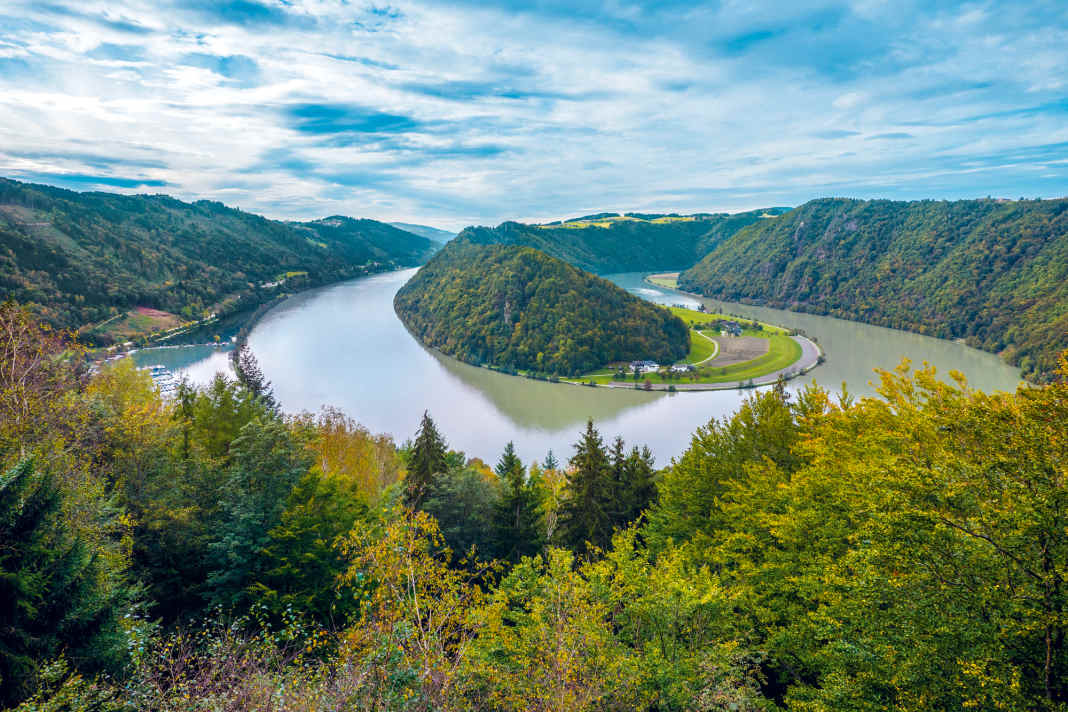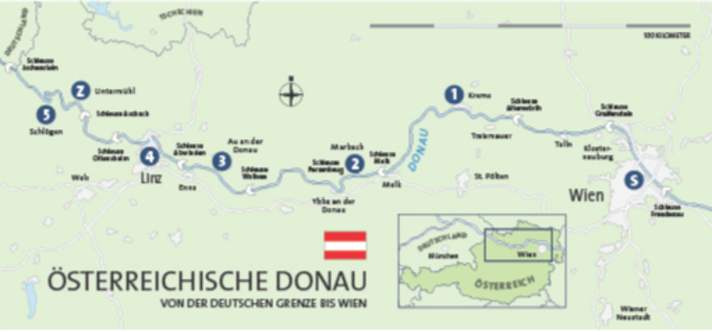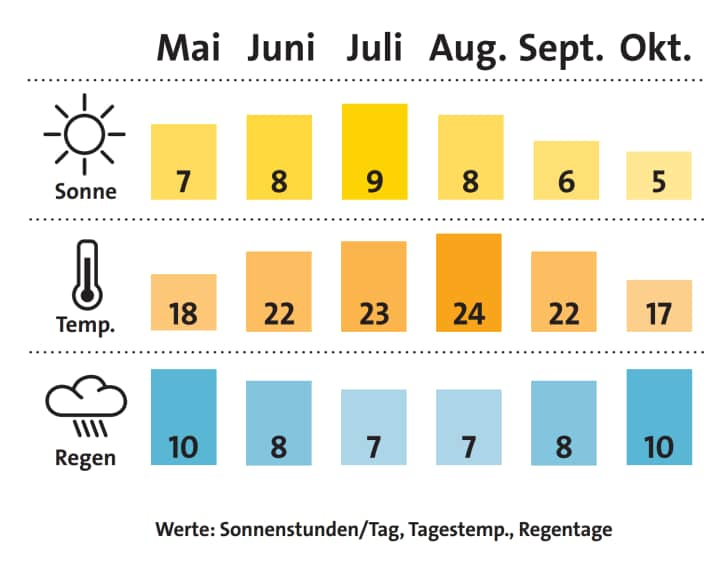





The second longest river in Europe has been one of the most important trade routes since time immemorial. The Romans called it Dānuvius and assigned the river god of the same name to it. We start our journey on the river in Vienna. The metropolis is a highlight on the Danube that we don't want to miss. Our charter boat "Julio", a Quicksilver Activ 905 Weekend with a powerful Mercury Verado 350, is actually stationed in Untermühl, the base of the company founded in 2019. Charter company Danube Yachts. Owner Thomas Schauer had suggested starting in the home port and then sailing back again, which is over 500 river kilometres. It is better to allow two weeks for this, otherwise there is hardly any time to explore the beautiful destinations. As he was on tour himself, the boat was in Vienna anyway and we were able to take over there. One-way trips are generally also possible for charter customers with appropriate planning.
The Marina Vienna offers every comfort. The two harbour basins are fenced in and therefore only accessible to guests. If you want to head east, you will pass the border with Slovakia after a good 50 kilometres of the river, but we want to go in the other direction. At least one day should be planned for exploring Vienna, as the city has so much to offer. As we take over the boat in the afternoon, we explore the nearby Prater in the evening. This can be reached on foot, but we use the underground, as the Donaumarina stop is right next to the harbour basin, so it couldn't be more convenient. The third stop takes us to the world-famous Wurstelprater amusement park. Where the devil is usually loose, there is an eerie silence, as the rides are closed due to the coronavirus crisis. However, the restaurants are open. They serve solid fairground fast food.
View of Vienna's historic city centre
The next day welcomes us with glorious sunshine. Perfect for exploring the city. You can't do everything in one day. We start with Belvedere Palace and then take a leisurely stroll towards the centre. Built at the beginning of the 18th century for Prince Eugene of Savoy, the palace grounds make for a lovely walk in the Belvedere Gardens with a view of Vienna's historic city centre. When the coronavirus isn't wreaking havoc, the palace can also be visited from the inside. With the city centre in our sights, we soon reach the State Opera. A detour to the legendary Naschmarkt would be a good idea, but we are all set. As the Hotel Sacher is only a few steps away, a Sacher cake and a coffee speciality are of course a must. We savour the chocolate tartlet and the sun's rays in the bustling setting, accompanied by the clattering hooves of passing carriage horses. We continue through the bustling Carinthian quarter to St Stephen's Cathedral. If you want to shop, this is the place to be. We seek some peace and quiet in the beautiful Volksgarten next to the Burgtheater. From here, the route leads eastwards again to the Stubenviertel neighbourhood with its numerous restaurants. Our destination is probably the best-known restaurant for Wiener Schnitzel, the Figlmüller. If you haven't booked a table here, you're unlikely to get one. We are lucky. After savouring the legend with perfect breadcrumbs and potato and gnocchi salad - there are linguistic differences - it's time to head back to the marina, where we round off the evening on board.
Gliding along the Danube towards Krems
The next morning we have to drive to Krems. The sun has left us. Around 75 kilometres including two locks have to be mastered, with a stop in Tulln as the tank is not full and the petrol station in Krems is closed. Although the glider is fast, you have to allow four to five hours for the journey, as locks take time. You often have to wait for commercial vessels. As there is a radio on board, everything can be discussed with the lock staff. They then give instructions about waiting times. Everything is very friendly. The chambers are large and the lift is enormous. In the afternoon we sail into the harbour of Motor Yacht Club Wachau in Krems. People have been drawn to the Danube for a long time. This is proven by the local discovery of a sculpture from the Ice Age that is over 30,000 years old. There have been settlements here since the 7th century. Today, viticulture dominates the region and the town is surrounded by vineyards. Although the area is known for its very low rainfall, we can expect constant rain: After a brief tour of the picture-perfect old town, we quickly seek shelter. Unfortunately, it's Monday and our planned destination, the oldest inn in Krems dating back to 1556, Zum goldenen Hirschen, is closed, as are most of the other pubs. The Ja Mas is our saviour: we dine excellently at the local Greek restaurant.
On the 50 kilometres to our next destination, Marbach, we soon pass the picturesque Dürnstein with its unmistakable blue tower, one of the Wachau's landmarks. A little later, Schönbühel Castle with its "cow and calf" danger spot. Although the weather is not ideal, we enjoy the landscape with the beautiful places on the banks of the Danube. In the early afternoon we reach the Marbach marina. The guest jetty is directly behind the entrance. Although there are plenty of places available, the pits are too small. Only the head of the jetty remains for mooring. If you need electricity or water, you need very long cables and hoses. We have no chance. We don't find any sanitary facilities. We learn later that the facilities at the campsite further away can be used. It is clear that the September season is over, as there is no-one in the floating beer garden at the end of the harbour either. It doesn't take long to explore the pretty little village. At our destination for dinner, the country inn Zur schönen Wienerin, which also manages the moorings, the doors are closed. Rest day. As there are no alternatives, we decide to walk to the neighbouring village of Granz, where the Rialto pizzeria saves the evening.
Next destination: Au an der Donau
The next day finally welcomes us with bright sunshine. Our destination is Au an der Donau. But first there are 57 kilometres of driving with a fuel stop. The 400-litre tank is far from empty, but it won't last as far as the filling station in Schlögen with a consumption of at least 65 litres per hour, which the 350 Verado allows itself to consume even when driving economically upstream. So we head for the tanker in the leisure harbour of Ardagger. The petrol station attendant is already waiting for us.
When we arrive in Au, the harbour host Monika Geppl welcomes us and shows us to the restaurant. The local motor yacht club offers a beautiful jetty with every luxury and perfect service. During a chat over coffee and cake in the warming afternoon sun on the beautiful terrace, it quickly becomes clear that this is a very dedicated organisation committed to perfect service. After a brief interruption, the chat moves on to the evening round. Club president Christian Schuhmayer joins us, and Monika has long since prepared her schnitzel. Honestly, we have never been better received as guests than here. The small village offers other catering options. A large children's playground borders the harbour.
Departure with the "Julio" to Linz
The next morning surprises us with fog. So we treat ourselves to a relaxed breakfast and wait and see, because the "Julio" doesn't have radar. The strong sun quickly burns away the haze. We can set off for Linz. Austria's third largest city is reached after 25 kilometres under a blue sky.
The guest jetty is located at the end of the winter harbour and is protected by a fence. The gate can only be opened with a code. You are supposed to get this after calling the number in the payment box - but nobody answers. After a phone call to the charter company, it works after an hour. After the service paradise of Au, you end up in the service desert of Linz. Sanitary facilities? Not a chance. At least there is electricity and water. Perhaps a guest pitch at the clubs on the north bank is the better solution. The annoyance is quickly forgotten, because Linz is a jewel. A marvellous walk along the Danube leads into the city. Sculptures by renowned artists turn the path into an adventure trail. At the end, the Lentos Art Museum awaits visitors. The route continues to the city centre via the main square into the pedestrian zone of the old town. Shopping is just as much the order of the day here as lingering in coffee houses. We opt for a Linzer Torte at Traxelmayr and enjoy the sun on the terrace. On the way back, we stop off at the Hofkneipe in Ludlgasse and enjoy the Austrian cuisine.
The best marina on the Austrian part of the Danube
The next destination is the Schlögen marina. Although it is located behind the charter base in Untermühl, it is the best marina on the Austrian part of the Danube. On arrival, we are greeted by the very dedicated harbour master Franz Ebner. We quickly find a berth on the concrete jetties. The facilities are perfect. There is also a restaurant. Here you are moored in marvellous natural surroundings directly on the Schlögener Schlinge. Many German owners from Bavaria, just a few kilometres away, also have their home port here. It doesn't take long for us to strike up a conversation with BOOTE readers. To enjoy the view over the Schlögener Schlinge, there is no way around climbing the lookout point. The ascent takes half an hour and is rewarded with a magnificent panorama. The next morning, the return journey to Untermühl. After 19 kilometres, we reach the small harbour. Charterer Thomas Schauer, who is also the new operator of the marina, explains his plans for the complete remodelling to make it much more comfortable. We are excited to see how things develop and are very satisfied after a week on the beautiful Danube with wonderful and extremely varied destinations.
Service

Cruise stages
- Vienna - Krems: 76 km
- Krems- Marbach: 48 km
- Marbach- Au an der Donau: 57 km
- Au an der Donau- Linz: 25 km
- Linz- Marina Schlögen: 55 km
- Marina Schlögen- Untermühl: 19 km
- Total distance: 280 km
The TOP 3 in the district
- Vienna: The offer is huge and there is so much to discover. In addition, a top marina with excellent transport connections awaits guests ( www.marina.at ).
- Motoryacht-Club Au an der Donau: The very committed association with equally committed members is extremely hospitable and does everything for the well-being of its visitors ( www.myc-au.at ).
- Marina Schlögen:The large marina in the middle of nature offers peace and quiet and a comprehensive full service. Visitors miss nothing here ( www.freizeitanlage-schloegen.at ).
Nautical information
The precinct: The Danube is a busy waterway. The current is very variable and, according to the Danube Commission, fluctuates between 3 and 10 km/h in the Upper Danube at average water levels. Freighters and excursion boats are omnipresent. The locks are designed for commercial traffic, which has priority. Anyone wishing to pass through the locks must register via VHF. The channels are signposted. If you do not have a radio licence, you can also make contact by telephone, but you should also listen to the radio traffic in this case, as transmitting is prohibited without a licence. Persons on deck must wear life jackets when locking the locks. Waiting times must always be taken into account. Sometimes there are waiting areas for pleasure craft in front of the locks, even outside the fairway and therefore without a current. Here, however, you must pay close attention to the water depth, which is dangerously low in some areas. Mooring is only possible in individual cases, usually the waiting time must be spent with the engine running and travelling slowly, occasionally even in the current. The very hospitable marinas are mostly run by clubs. Contact persons are not always on site. This is why key boxes and codes on call are used. Legal regulations are available from the ADAC: www.skipper.adac.de/reviere/ under the country code "Austria"
Driving licence: The prerequisite for driving motorboats is an official inland waterway recreational craft licence.
Weather/climate

Literature
"The Danube. From Kelheim to the Black Sea". By Melanie Haselhorst and Kenneth Dittmann. Delius Klasing Verlag, 3rd edition, 2019; 328 pages, format 17.9 x 24.6 cm; €36.90. ISBN: 978-3-667-11230-9. www.delius-klasing.de
Online chart Danube. You can find a detailed nautical chart of the part of the Danube travelled for trip planning at: https://at.d4d-portal.info/

Our boat: Quicksilver Activ 905 Weekend (GRP glider) - length: 8.91 m - width: 2.98 m - draught: 0.63 m - cruising speed: approx. 43 km/h (against the current), maximum speed: approx. 50 km/h (against the current) - fuel tank: 400 l - water tank: 100 l - engine: 350 hp (outboard) - equipment: plotter, VHF, inside steering position, 2 double cabins with 4 fixed berths, kitchenette, WC/shower, air conditioning/heating (only with shore power). Recommended crew for stays of several days on board: up to four persons
Charter: The Quicksilver Activ 905 Weekend is available at Donau Yachten (www.donau-yachten.com) between May and October with or without skipper. Charter for 3 days (from € 1494), 4 days (from € 1743) or a week (from € 2490). A skipper costs 65 €/h(as at 2021)
This article appeared in BOOTE issue 4/2021 and was revised by the editorial team in August 2023.

